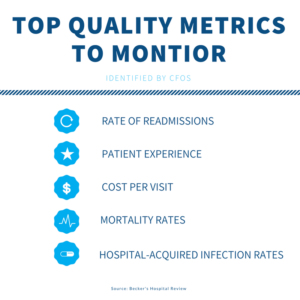May 9, 2018
Successful Healthcare CFOs Obsess Over Quality of Care

Quality of care is more important than ever in healthcare. While health system CFOs have traditionally focused on the costs of healthcare delivery and bottom line financial impacts of every purchase or implementation, progressive financial leaders are shifting more of their attention to quality improvements across the board.
Why Quality Matters to Progressive CFOs
Quality of care ties more directly to reimbursement than ever before, no matter how controversial some of the pay-for-performance policies have become. Take some of these recent shifts in payment models as examples.
More Hospitals Joining ACOs
Accountable Care Organizations reached an all-time high in 2018 with 561 participants, an 18 percent jump from 2017. This year’s ACOs include 1,517 hospitals, 2,560 federally qualified health centers, 1,210 rural health centers, and 421 critical access hospitals. Only 9 percent of ACOs dropped out of the program from 2017 to 2018, which is another overall display of strength for the future of the ACO model.
New Bundled-Payment Model
Just two months after CMS canceled two of its mandatory bundled-payment models in November 2017, it added one new voluntary bundled-payment model in January 2018. This is yet another step in fine-tuning the pay-for-value model that rewards high-quality care.
Changes to CMS’ Value-Based Purchasing Program
In 2018, CMS is giving equal weight to each of the four domains that determine the incentive payouts to acute-care hospitals:
- Safety
- Clinical Care
- Efficacy and Cost Reduction
- Patient and Caregiver-Centered Experience of Care/Care Coordination (to be aptly renamed Person and Community Engagement in FY 2019)
With a full 25 percent of the VBP score attributed to HCAHPS survey results, it’s hard to ignore the significance of quality patient experience.
Heads Up: Quality Metrics CFOs Need to Watch

According to Becker’s Hospital Review, CFOs identified the following as the top quality metrics to monitor:
- Rate of Readmissions
- Patient Experience
- Cost Per Visit
- Mortality Rates
- Hospital-Acquired Infection Rates
Use these metrics to look for opportunities to improve the patient experience — from the front desk to the back office — including billing and payment interactions before, during, and after the care encounter.
Invest in the Patient to Get Timely Payments
Solutions that keep patients informed and respected throughout their healthcare journey are worth the investment because engaged patients pay. The ideal patient experience starts before the care encounter begins with open and easy communication on the channels and devices patients want to use, and extends beyond the encounter with how your health system handles billing conversations.
Are you sensitive to each patient’s financial situation and ability to pay?
Are you offering patients multiple options for where to pay, how to pay, how much to pay, or alternatives to traditional payments?
Are you treating each patient as an individual and tailoring your communications and billing solutions to their needs and preferences?
Taking a holistic view of the patient experience will go a long way to boosting quality metrics outside of the encounter to impact your bottom line. Consider investments that will free up your health system’s most important resources — your clinicians and staff — allowing them to focus more on patient interaction and customer service to make an impact on satisfaction, outcomes, loyalty, and likeability.
In an upcoming blog post, Ignore Quality of Care Metrics at Your Own Peril: Three Financial Risks, we’ll discuss the repercussions of overlooking quality of care as part of the revenue cycle equation.
RevSpring Can Help
Integrated payment communication is part of RevSpring’s DNA. We tailor the payment conversation to influence behavior and inspire action. Our segmentation rules and workflows help you become hyper-focused on the patient, understanding the patient’s ability to pay and mapping his or her financial obligations to repayment pathways.
If you’d like to learn more about our comprehensive patient engagement and billing solutions, we’d love to help you. Request a demo to see how we can help your organization meet its goals.